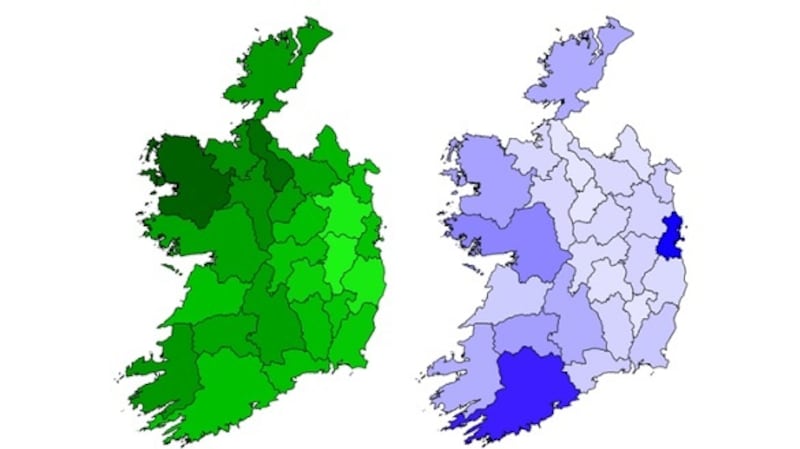Since 1991 the Irish census has asked people to report whether they lived outside the State for one year or more, their country of previous residence, and year of last taking up residence in Ireland. When controlled for birthplace and age, those questions yield important information about return migration to Ireland.
The full results of this year’s census will not be released until 2017, so the most recent data comes primarily from the 2011 census. It showed about 400,000 Irish-born people who previously lived abroad were then living in Ireland, and can therefore be classified as return migrants. They comprised 8.7 per cent of the total population.
When they returned

The first chart illustrates return migrants in Ireland in 2011 by decade of last taking up residence in the state. About the same percentage returned in the 1970s and 1980s, though academic discussions of return tend to concentrate on the former as a decade of economic growth. Because the 1980s witnessed such high levels of emigration, immigration gets overlooked.
About half of returnees enumerated in 2011 moved back to Ireland during the Celtic Tiger, but more have continued to return since the recession. Estimates for 2010 to 2015 record that a yearly average of 40,700 Irish people left the country, while 16,300 returned.
The preliminary results of the 2016 census show a total net migration of -28,559 over the last five years, which factors in a net inward migration of 115,800 (this number includes returning Irish citizens and immigrants). Combined, the evidence suggests that while net emigration has dominated migration trends historically, return has always been a factor.
Age
In profiling return migrants by age group, the two peaks in the chart around age 40-44 and 65-69 point to the respective impacts of the post-war and 1980s emigrant generations. Women slightly outnumber men overall in the census data (though not in estimates of recent return migration).
Popular discourse - such as the government’s #HomeToWork campaign - often rests on the assumption that migrants want to come “home” and would do so if suitable job opportunities existed. But this neglects the myriad of non-economic reasons people have for coming back to Ireland at different stages of their lives - whether family obligations, raising their own families, being closer to friends - as well as those who return after retirement.
The last is important because age can exacerbate the challenges of readjustment. People over age 60 comprised 31 per cent of returnees in 2011. Return migrants made up 16 per cent of the age group as a whole, highlighting the high levels of emigration among that generation in the post-war era.
Where they lived abroad
Just over half of all returnees previously lived in the United Kingdom, which is unsurprising given it was the primary destination for Irish migrants for much of the 20th century. 11.6 per cent had lived in the US.
Smaller numbers of migrants found their way across the globe and back again, as the map illustrates. The data is incomplete because countries that received only small numbers are grouped together and therefore not shown on the map, but it nonetheless shows the global reach of the diaspora and its influence on Ireland.
This data can also highlight generational differences in migrant destinations. The 2011 census recorded that among those born before 1951, 73 per cent previously lived in the UK, while for those born in the 1970s and 1980s the corresponding number was 37 per cent. A much higher proportion of the younger generation lived in the EU (10.6 per cent) and in other countries abroad (42.2 per cent), including Australia.
Where they returned to
While movement from rural Ireland to urban areas abroad characterised emigration historically, the reverse characterises return. Migrants tend to go back to their place of birth or a place where they have connections. Thus, the western counties that witnessed the highest levels of emigration during the 20th century (and continuing into the 21st) also reported the highest proportion of returned migrants.
The first map shows return migrants as a percentage of the total population in each county in 2006. The counties with the highest proportions - Mayo comes in on top at 14.9 per cent, followed by Leitrim, Sligo, Roscommon, Donegal, and Kerry - exemplify return migrants' attraction to "home" as a local place.
Job creation as a result of multinational investment and industrial expansion explains rates of return in some counties, particularly around cities. The second map shows the data in absolute numbers (rather than as proportions). It illustrates that while urban areas attract high numbers of returnees, so too do the same rural western counties. Although this data relates to 2006, these patterns have remained consistent over the last three decades and it is reasonable to expect them to continue when the 2016 census results are released.
This data, combined with personal narratives, suggests that economic factors alone cannot explain return migration. The Government’s blinkered emphasis on work ignores the reality many returnees experience of housing shortages, the need for social services for elderly retirees, and difficulty finding school places for children. While Ireland’s global migrants may still call this island home, it will take more than jobs for them to be at home here.
Sources: Central Statistics Office, Census of Population of Ireland, 2006 and 2011; Central Statistics Office, Population and Migration Estimates, April 2015; Central Statistics Office, Census 2016 Preliminary Results, July 2016.
Sara Goek holds a Ph.D. in History and Digital Arts & Humanities from University College Cork. She blogs at saragoek.wordpress.com and tweets @SaraGoek.


















